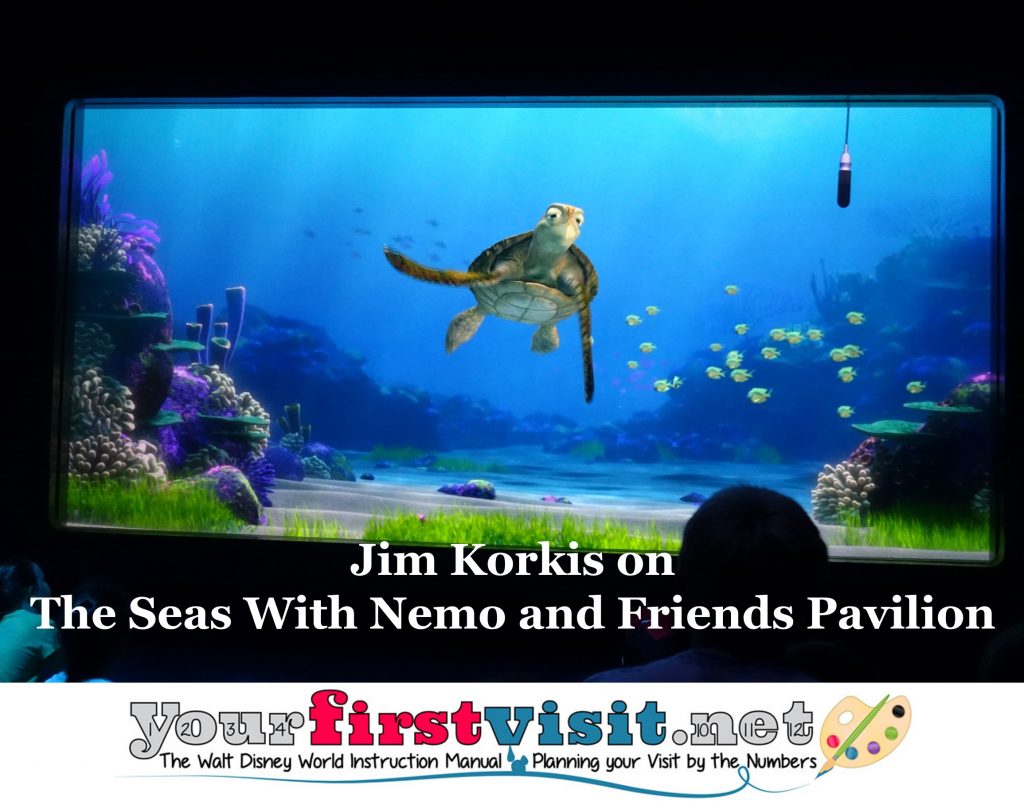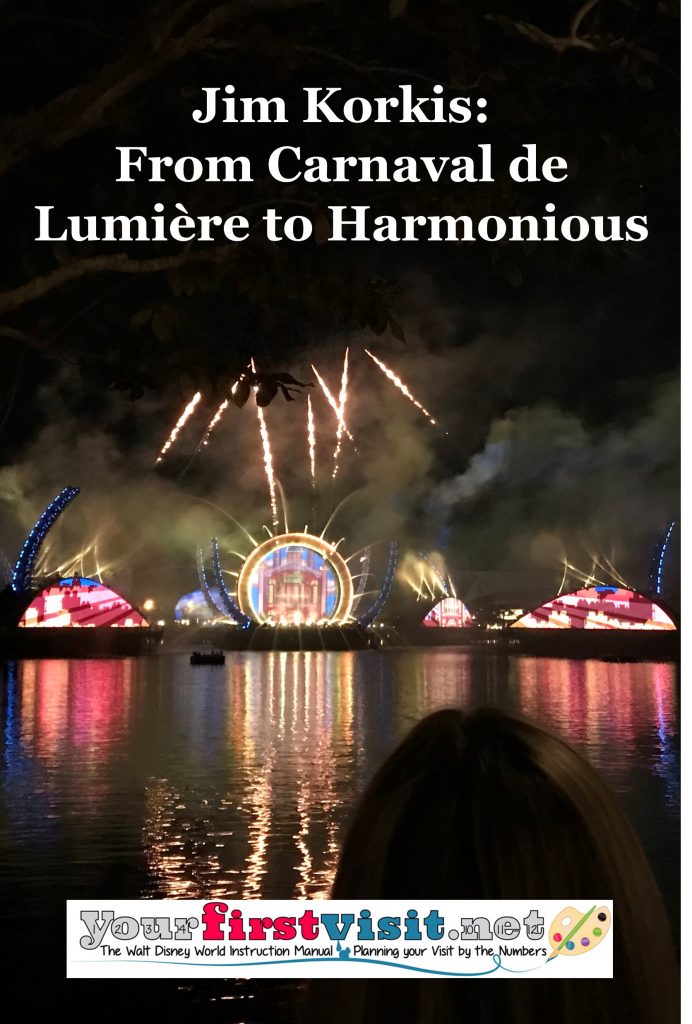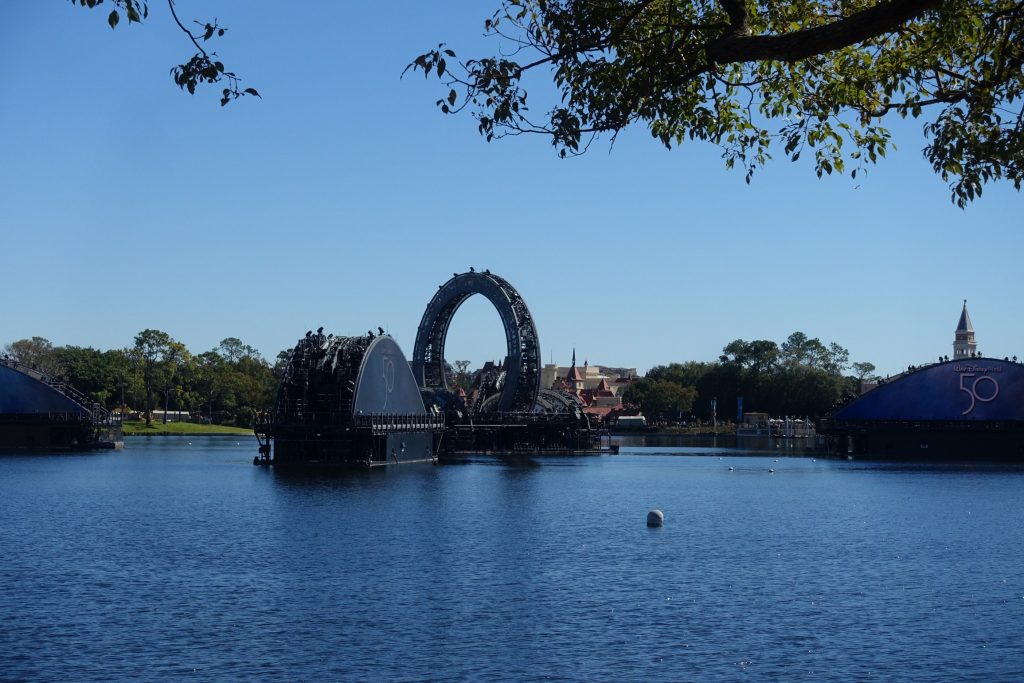Category — A Friday Visit with Jim Korkis
Fridays with Jim Korkis: Walt’s Apprentice by Dick Nunis
Welcome back to Fridays with Jim Korkis! Jim, the dean of Disney historians, writes about Walt Disney World history every Friday on yourfirstvisit.net.
YOUR PERSONAL DISNEY LIBRARY (58)
By Jim Korkis
- Walt’s Apprentice by Dick Nunis
No one was more excited than I was when I heard that Dick Nunis had written a book, and no one was more fearful than I was when I heard it would be published by Disney Editions.
The fear was that Nunis’ many colorful stories would be neutered or missing, and that is unfortunately the case with this book. For instance, his recounting of the Yippie Invasion of Disneyland in 1970 in Walt’s Apprentice is like a brief three page Cliff Notes’ version of the event and downplays Nunis’ aggressive participation where he tackled one of the activists and ripped off his wig.
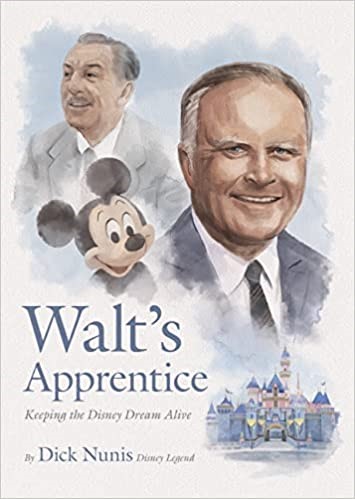
Nunis is deservedly a Disney Legend and without him many agree that Walt Disney World would never have opened on time. He is strongly opinionated and is surrounded by outrageous but true stories. He is a controversial and polarizing figure with many people willing to follow him into Hell and others feeling he was the devil himself.
However, everyone respected him and never questioned his commitment to Disney and especially Walt and his brother Roy. He was always considered tough but fair and some stories reveal instances of unexpected kindnesses and patience.
When he felt he was unfairly ousted from Disney, he refused to talk about his decades with the company even to the point of having people physically removed from his office who came to interview him. In the book, he writes that Eisner did not shed a tear when Nunis retired, just one of many subtle undertones that reveal Nunis’ true feelings that are easily missed.
Nunis was there the first day that Disneyland opened in 1955 and served in a variety of roles for forty-four years. Many of the things done at Disneyland and Walt Disney World were directly the result of Nunis even when Walt and Roy were alive.
I would describe Walt’s Apprentice as a “snapshot” memoir spotlighting a handful of moments in his life. Nunis suggests he depended upon others to help him remember.
Each chapter is only about three pages long because Nunis intended them to be an example of something he learned. At the end of each chapter is a short sentence summarizing what he learned and hope the reader will as well.
Certainly, this is not out of character for Nunis, who spent much of his time at Disney as a living model of behavior and had no hesitation in mentoring others. Along with Van France, he developed the first training programs for Disneyland.
The 320 page book has a center insert of thirty-two pages of photos (although some are not fully identified). While this is not the book I hoped to see from Nunis, it was an immediate best seller and there is no question that it should be included in the collection of any true Disney fan.
In addition, there is some surprising new information that appears nowhere else like Nunis’ discussion about his efforts to build a Disney theme park in Australia and how at the last minute, Eisner dismissed the idea and decided on Hong Kong instead. It was one of many disagreements with Eisner that led to Nunis’ retirement.
* * * * *
Thanks, Jim! And come back next Friday for more from Jim Korkis!
In the meantime, check out his books, including his latest, Off to Never Land: 70 Years of Disney’s Peter Pan and Final Secret Stories of Walt Disney World!
Follow yourfirstvisit.net on Facebook or Twitter or Pinterest!!
December 30, 2022 No Comments
Fridays with Jim Korkis: Walt Disney World Prices 50 Years Ago
Welcome back to Fridays with Jim Korkis! Jim, the dean of Disney historians, writes about Walt Disney World history every Friday on yourfirstvisit.net.
PRICES OF WALT DISNEY WORLD IN 1971
By Jim Korkis
As we bring to an official close the 50th anniversary celebration of Walt Disney World, here is a quick look back at prices in October 1971 when Walt Disney first opened.
An adult admission to the Magic Kingdom for one day was $3.50 (plus additional cost for tickets to individual attractions) and fifty cents for all day parking. A Junior (under 18) was $2.50 and a Child (under 12) was $1.00.
Basically, the cost of admission to the park was the same cost as buying about three gallons of milk at the local grocery store. To put that price in better perspective, in 1971 a movie ticket cost $1.50, gas was forty cents a gallon, a Malibu Barbie doll was about two dollars, and postage stamps were eight cents.
Admission only got you into the park—not on any rides (except free rides paid for by corporate sponsors). For each ride, you needed to pay for an additional ticket—the famous A through E tickets.
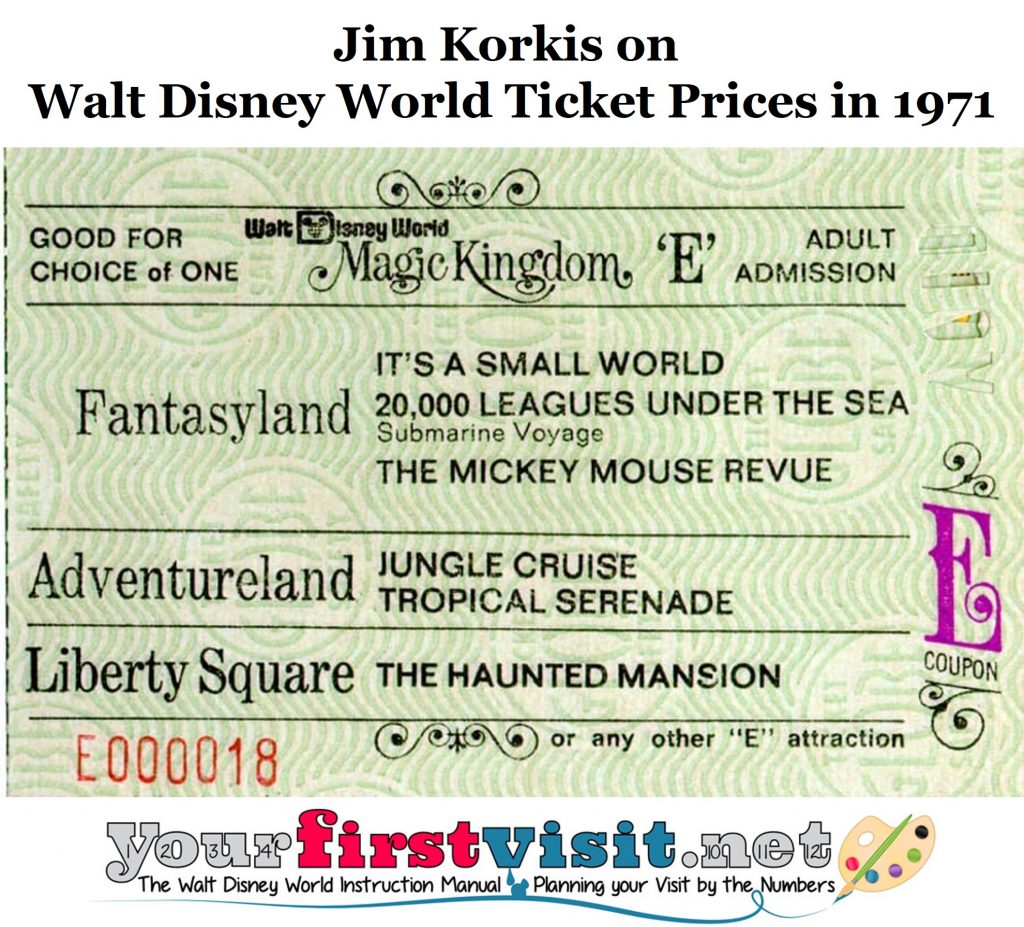
A “B” ticket (twenty-five cents) was good for a visit to the Main Street Cinema, Frontierland’s Shootin’ Gallery, Mike Fink Keelboats, or Adventureland’s Swiss Family Treehouse.
A “C” ticket (fifty cents) was good for Tomorrowland’s Grand Prix Raceway, Fantasyland’s Dumbo the Flying Elephant, Peter Pan’s Flight, Snow White’s Adventures, Mr. Toad’s Wild Ride, Mad Tea Party or Frontierland’s Davy Crockett’s Explorer Canoes (these closed at dusk with a reminder of that fact on the ticket itself, to avoid disappointing guests).
A “D” ticket (seventy-five cents) was good for the Main Street Railroad Train Grand Circle Tour, Tomorrowland’s Skyway to Fantasyland, Flight to the Moon, Fantasyland’s Skyway to Tomorrowland, Frontierland’s Country Bear Jamboree, Liberty Square’s Admiral Joe Fowler Riverboat or The Hall of Presidents.
An “E” Ticket (eighty cents) was good for Fantasyland’s “it’s a small world”, The Mickey Mouse Revue, 20,000 Leagues Under the Sea Submarine Voyage, Adventureland’s Jungle Cruise, Tropical Serenade (name changed in September 1972 to Enchanted Tiki Birds and dropped to a “D” ticket), or Liberty Square’s Haunted Mansion.
Riding all the ~30 listed rides at the ticket prices was about another $15/day—more than four times the cost to enter the park. Many guests chose to save money on a few of these rides by buying a ticket book. Admission and seven assorted tickets for adults were $4.25, and an eleven ticket book was $5.75.
To entice guests to come to Walt Disney World, Disney offered a bargain “Vacation Kingdom” package.
It included accommodations for three nights at either of the Contemporary Resort or the Polynesian Village Resort, four days of unlimited use of Walt Disney World transportation system, four admissions to the Magic Kingdom, twenty-eight “Theme Park Adventure” ticket coupons good for any of the attractions, and thirty dollars worth of recreation coupons. (Total cost was Adult $90, Junior $36 and Child $35.50)
Recreation coupons? As a vacation destination, Walt Disney World was more than just another theme park experience, so there were many other options from golfing to recreational watercraft to tennis, horseback riding and more.
The cost of a room at the Contemporary or Polynesian varied according to the size, location and season but in general a guest would expect to pay between $22 -$48 a night.
Pets could stay at the Kal Kan Kennel Club for fifty cents per day and a dollar overnight and that included a free meal for the pet. Wheelchair rental was a dollar.
* * * * *
Thanks, Jim! And come back next Friday for more from Jim Korkis!
In the meantime, check out his books, including his latest, Off to Never Land: 70 Years of Disney’s Peter Pan and Final Secret Stories of Walt Disney World!
Follow yourfirstvisit.net on Facebook or Twitter or Pinterest!!
December 26, 2022 No Comments
Fridays with Jim Korkis: The Early Years of Disney at Disney’s Hollywood Studios
Welcome back to Fridays with Jim Korkis! Jim, the dean of Disney historians, writes about Walt Disney World history every Friday on yourfirstvisit.net.
THE HOLLY-VERMONT REALTY OFFICE AND THE BEGINNING OF DISNEY STUDIO
By Jim Korkis
As the Walt Disney Company celebrates the centennial of its creation in 1923, Disney’s Hollywood Studios has always had a physical homage to honor that creation.
When Walt Disney came out to Los Angeles from Kansas City in August 1923, he lived with his Uncle Robert who charged him a weekly rent of five dollars as well as an additional dollar for using the garage to try to do animation.
When Walt got the contract from a New York film distributor to do twelve episodes of the Alice Comedies animated series with an option for more, he walked down the street two blocks west from Uncle Robert’s house to the Holly-Vermont Realty office.
Walt told the owners of the office that he only needed enough room “to swing a cat in”, meaning just a limited space, and could only afford a maximum of ten dollars a month. He was given a room at the back of the real estate office. Walt and Roy had to put up a curtain to block the room from the activity in the rest of the office.
As former Disney Archivist Dave Smith wrote to me in March 1982, “Walt moved down the street on October 8, 1923, to 4651 Kingswell Avenue, and there in the back of a real estate office set up the first Disney Studio. A contract was signed for the Alice Comedies on October 16, 1923, and we consider that the official date of the beginning of the Disney Studio.”

Image (c) Disney
At Disney’s Hollywood Studios to the right side of Peevy’s Polar Pipeline refreshment stand is a door with the logo for the Holly-Vermont Realty Office.
The owners of the real Holly-Vermont Realty Office rented Walt a room in their building from October 1923 to February 1924, when Walt moved to a larger space next door at 4649 Kingswell Avenue. The sign in the upper window listing space for rent at Disney’s Hollywood Studios suggests that Walt has already moved out to bigger and better things.
The Disney Brothers Studio was unique because at the time it was the only animation studio in California. All other animation studios were primarily in New York.
In that small studio space, Walt Disney single-handedly wrote, designed, directed and animated Alice’s Day at Sea, finished in December 1923. It was a silent film in black-and-white with a simple story of a live action young girl going to the beach with her dog and falling asleep. She dreams of having adventures under the sea with animated creatures of the deep.
Walt’s older brother, Roy, the business manager, doubled as company cameraman, photographing both the animation and the live action. The star was six year old Virginia Davis, who told me in a 2007 interview, “It’s amazing to think that from this cartoon comes the Disney entertainment empire. We filmed it at Santa Monica. It was the first time I had seen an ocean.
“There was no script. Walt would tell me the story but it was exciting because I was in the story. There was no rehearsal at all. Since it was silent, he would tell me off camera where to look and how to react.”
At Disney’s California Adventure on Buena Vista Street, there is a sign for “Hollymont Property Associates” referencing the Holly Vermont Realty Company, as well as one for the Kingswell Camera Shop, referencing Kingswell Avenue, the street of the first Disney Studio.
* * * * *
Thanks, Jim! And come back next Friday for more from Jim Korkis!
In the meantime, check out his books, including his latest, Off to Never Land: 70 Years of Disney’s Peter Pan and Final Secret Stories of Walt Disney World!
Follow yourfirstvisit.net on Facebook or Twitter or Pinterest!!
December 16, 2022 No Comments
Fridays with Jim Korkis: The Seas With Nemo and Friends
Welcome back to Fridays with Jim Korkis! Jim, the dean of Disney historians, writes about Walt Disney World history every Friday on yourfirstvisit.net.
THE SEAS WITH NEMO AND FRIENDS AT EPCOT
By Jim Korkis
The Seas with Nemo and Friends pavilion originally opened at Epcot in 1986 as the Living Seas Pavilion. The original version took guests to the depths of the ocean via “hydrolators,” to an underwater research facility known as SeaBase Alpha. Up until November 2005, the pavilion featured the world’s largest saltwater tank when it was surpassed by the Georgia Aquarium in Atlanta.
Between December 2003 and the rededication in January 2007, the pavilion began to transform to the Seas with Nemo and Friends inspired by Disney•Pixar’s Finding Nemo (2003). It became the first Epcot pavilion to be based on a Disney animated movie property, as the Imagineers added Turtle Talk with Crush, replaced the original seacab omnimover ride with an updated Finding Nemo experience now utilizing clamshell vehicles, and replaced the hydrolators and pre-show with an expanded queue and ride experience.
The catalyst for envisioning a whole new attraction was top-secret technology developed by Walt Disney Imagineering Research and Development that enables the Nemo characters to swim alongside live fish in the immense salt water aquarium.
The projection technology was developed by research and development designer Alfredo Ayala.
“Alfredo played with it, developed it, and set up a demonstration,” said executive show producer and vice president Kathy Mangum. “That demonstration really opened up the opportunity for us to create the finale. The technology really drove what the creative application could be.”
Roger Gould, creative director of Pixar’s Theme Parks group, directed the new animation. “Making the film, we fell in love with Nemo, Dory, Marlin, Crush and the rest of the characters, so it was so much fun to bring them back to life in a way that allows our guests to be part of the adventure.”
“We built projection surfaces into the dimensional sets and rock work in the undersea environments that are seamless,” explained senior concept writer Kevin Rafferty, “so the magic of it is you see the characters you love from the film in this dimensional, underwater environment. There are times where it really seems as if the animated fish and the actual fish are interacting and sharing the same world. When that happens, it’s really glorious.”
The animation of Nemo and his aquatic pals was created by many of the same Pixar artists who animated Finding Nemo. Most guests miss some of the extreme attention to detail such as the moment Nemo swims out of a rusty pipe on the sunken submarine and little flakes of rust float out as well.
The undersea trek is enlivened by music orchestrated under the supervision of Thomas Newman, who composed the music for the film.
Robin Cooper, one of Pixar’s art directors on Finding Nemo, collaborated closely with the Imagineers to recreate the specific design of the coral reef from the film. “I started out in theater set design, so building the virtual world of the movie as physical sets was a thrilling experience for me. The Imagineers are artists and problem solvers, and every detail I described, they found ways to bring to life.”
“The technique allowed us to recreate the beautiful undersea world that was designed by Pixar for the film,” said Magnum. “What’s so important about this attraction is that it revitalizes the whole pavilion for us. Epcot is about exploring new places, and it was a natural fit to tell the story by using these characters.”
* * * * *
Thanks, Jim! And come back next Friday for more from Jim Korkis!
In the meantime, check out his books, including his latest, Off to Never Land: 70 Years of Disney’s Peter Pan and Final Secret Stories of Walt Disney World!
Follow yourfirstvisit.net on Facebook or Twitter or Pinterest!!
December 9, 2022 No Comments
Fridays with Jim Korkis: From Carnaval de Lumière to Harmonious
Welcome back to Fridays with Jim Korkis! Jim, the dean of Disney historians, writes about Walt Disney World history every Friday on yourfirstvisit.net.
CARNAVAL DE LUMIERE TO HARMONIOUS IN EPCOT
By Jim Korkis
Harmonious debuted at Epcot on October 1, 2021 as a nighttime spectacular on the World Showcase Lagoon to celebrate the cultures and stories of the world that have inspired various Disney films and music.
The five floating platforms newly added to World Showcase Lagoon to show it are positioned like a compass. The show’s central water curtain is five stories high. The show employs hundreds of programmable moving fountains and lights, plus lasers and pyrotechnic effects.
Harmonious tells a story of global connection, with a world tour of familiar Disney songs performed in more than a dozen languages by a cast of nearly 240 vocalists and musicians. Global connection is a major theme in the re-imagining of Epcot.
Harmonious replaced Illuminations: Reflections of Earth that was created and directed by Don Dorsey. That show premiered on October 1, 1999 and ran for approximately two decades until 2019. An interim show, Epcot Forever, was shown before the debut of Harmonious.
Le Carnaval de Lumière’s International Festival of Festival (which was the official nomenclature of the show that was often just called Carnaval de Lumiere, or “carnival of light”) was the very first nighttime spectacular at Epcot and premiered October 23, 1982 as part of the dedication ceremonies for the new theme park.
Carnaval de Lumiere was created and directed by Don Dorsey, who had been responsible for the Electrical Water Pageant on the Seven Seas Lagoon. It was referred to by the Walt Disney Company as “a celebration of celebrations”.
According to the dedication program: “Through kaleidoscopic tapestries of light and sound, Le Carnaval de Lumiere takes you across the entire world and through twenty centuries to experience the rich diversity – and the commonality – of human celebration.”
It was a presentation using rear projection screens on barges floating on the World Showcase Lagoon. Between the projection barges were fireworks barges controlled by Apple computers. The show could be viewed only from Showplace Plaza between Mexico and Canada at the front of the entrance to World Showcase.
Carnaval de Lumiere lasted only about eight months before being replaced by A New World Fantasy that debuted June 1983 and closed in 1984 to be replaced by Laserphonic Fantasy that premiered June 9, 1984. That show closed January 24, 1988 to be replaced by the original Illuminations that opened January 30, 1988.
A New World Fantasy was set to classical music played on synthesizer and was also supervised by Don Dorsey. The nighttime show used the same Carnaval de Lumiere floating barges that had rear projection screens on them. The show also added “Pichel lights” that moved automatically.
Laserphonic Fantasy used the same soundtrack as A New World Fantasy but incorporated lasers for the first time. It featured lasers emitted from barges and from around the lagoon, and for the first time guests could view the spectacular from anywhere around the World Showcase Lagoon. It was the first time for laser projections on water screens.
The projection barges were abandoned and the fountain and fireworks barges were arranged around a central barge containing lighting effects, fog effects, and lasers.
Laser projection booths were installed at Canada, Mexico, and American Adventure. The automation of the Pichel lights was completed and added to the show. Later, small fireworks barges and seawall fireworks were added to expand the show.
In none of these three shows were the individual country pavilions surrounding the lagoon spotlighted. That did not happen until another Dorsey show, the original Illuminations in 1988.
* * * * *
Thanks, Jim!
Harmonious has been wildly controversial, partly because of annoyance that it replaced the much loved (though not by me) Illuminations, partly because it continued the move (disheartening to many, though not to me) to introducing more film Disney content into Epcot, and partly because the enormous show barges new with it made World Showcase Lagoon look like a set from Battleship (2012).
In September 2012, it was announced that Harmonious would be replaced by another nighttime spectacular in 2023.
Come back next Friday for more from Jim Korkis!
In the meantime, check out his books, including his latest, Off to Never Land: 70 Years of Disney’s Peter Pan and Final Secret Stories of Walt Disney World!
Follow yourfirstvisit.net on Facebook or Twitter or Pinterest!!
December 4, 2022 No Comments
Fridays with Jim Korkis: 365 Walt Disney World Facts
Welcome back to Fridays with Jim Korkis! Jim, the dean of Disney historians, writes about Walt Disney World history every Friday on yourfirstvisit.net.
YOUR PERSONAL DISNEY LIBRARY (57)
By Jim Korkis
- 365 Walt Disney World Facts by Chadwick Miller
When I first noted the title 365 Walt Disney World Facts, I thought the concept was a clever idea, like those religious devotionals that have an inspiring chapter lesson for each day of the year. I should have been more suspicious.
How do you squeeze 365 facts into 136 pages especially if each fact is only one sentence long? The answer is to pad blank space between each fact. Without that extra wasted space, the book might run around thirty pages or less.
Chadwick Miller is a native of Georgia and describes himself as an amateur historian and theme park addict who is also an avid Star Wars collector, having presented on collecting at multiple conferences and conventions. He loves to travel and experience as many theme parks as possible.
Not being a student of Walt Disney World history, Miller is guilty of many misunderstandings that he presents in 365 Walt Disney World Facts as facts.
“The opening day cast members for Walt Disney World Resort were not trained on property or even at Disneyland. At the time Disney owned the Celebrity Sports Center in Denver, Colorado that they used for training new cast members.”
That statement will come as a shock to all those 1971 cast members who did indeed go through casting interviews on WDW property and did training at Florida’s Disney University. SOME of the management of WDW did get training in certain business disciplines while working at the Celebrity Sports Center.
“Expedition Everest is the first Disney attraction to send guests backwards through an attraction.”
Many of us remember the Maelstrom at the Norway Pavilion at Epcot that was doing the same thing for more than a decade before Expedition Everest opened.
“The Eiffel Tower in the France Pavilion is the only structure that is considered a ‘carrot’ in the World Showcase. It is essentially the only thing guests cannot actually reach.”
Okay, where do I start with this misinformation? First the Disney term is not “carrot” (a treat always out of the reach of a poor donkey to get it to drag a burden to a specific destination) but a “weenie” (a term Walt created based on him playfully giving a hot dog reward to his beloved pet dog). Disney is sometimes embarrassed by the inelegant term and in its professional development classes refers to it as a “visual icon”.
There are many “weenies” in World Showcase. The American Adventure pavilion is considered a major one, that pulls guests to the far end of the area. As we all know, there are many, many things in World Showcase that guests cannot reach.
What makes this information especially fraught is that since there are only 365 or so sentences in the book, so each one carries more “weight”. The impression is that a casual Disney fan scanned the internet for some quick copy and did not always understand or mis-interpreted what he was reading.
Not all the information is incorrect, but enough is that everything becomes suspect. What I worry about is that readers will pick up this book and assume it must be accurate because, after all, it’s in a book.
So while this is a great idea, the execution is exceedingly poor and this book should be avoided unless you are a completist who wants to have every WDW book.
* * * * *
Thanks, Jim! And come back next Friday for more from Jim Korkis!
In the meantime, check out his books, including his latest, Off to Never Land: 70 Years of Disney’s Peter Pan and Final Secret Stories of Walt Disney World!
Follow yourfirstvisit.net on Facebook or Twitter or Pinterest!!
November 25, 2022 No Comments

